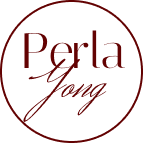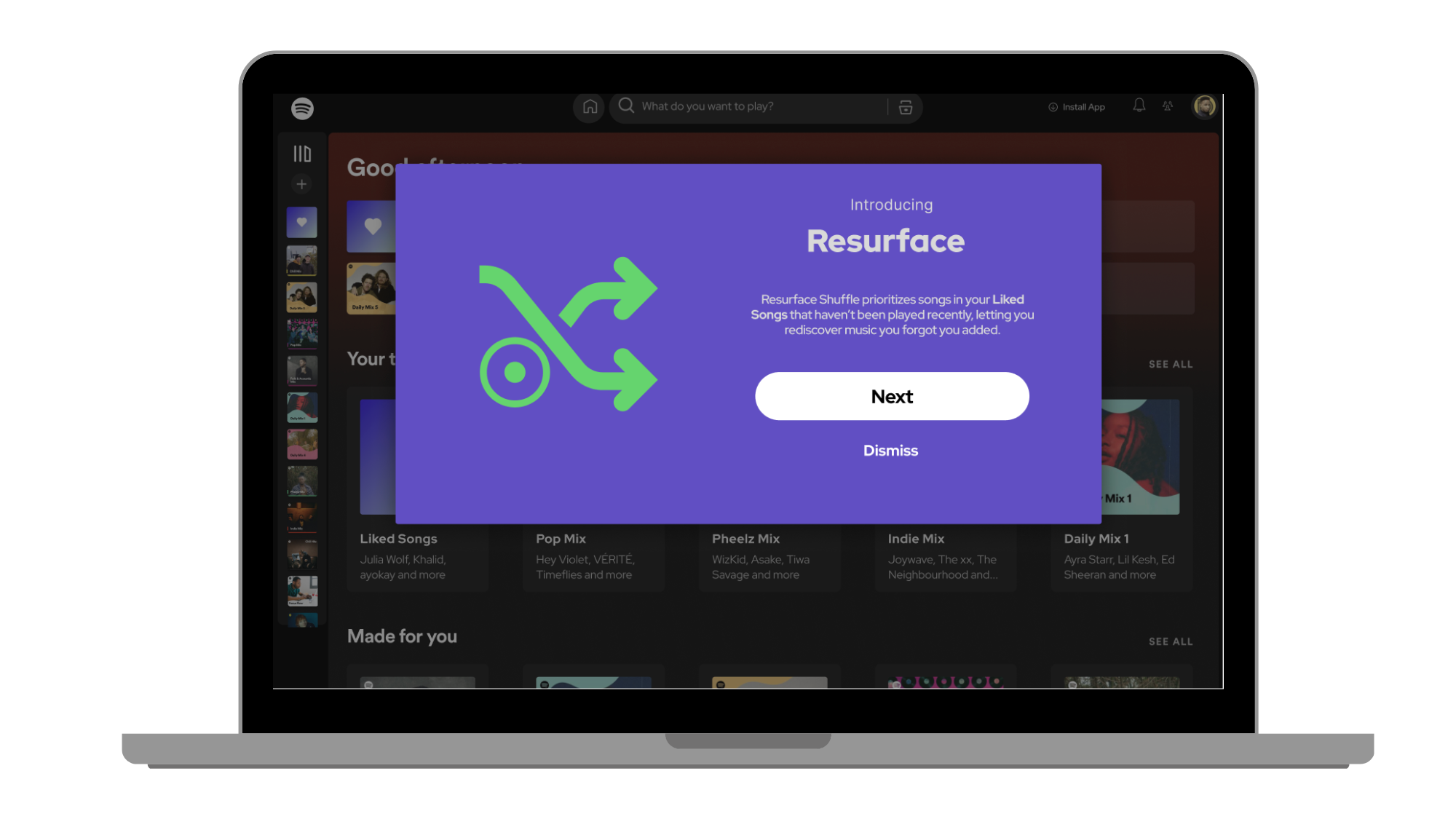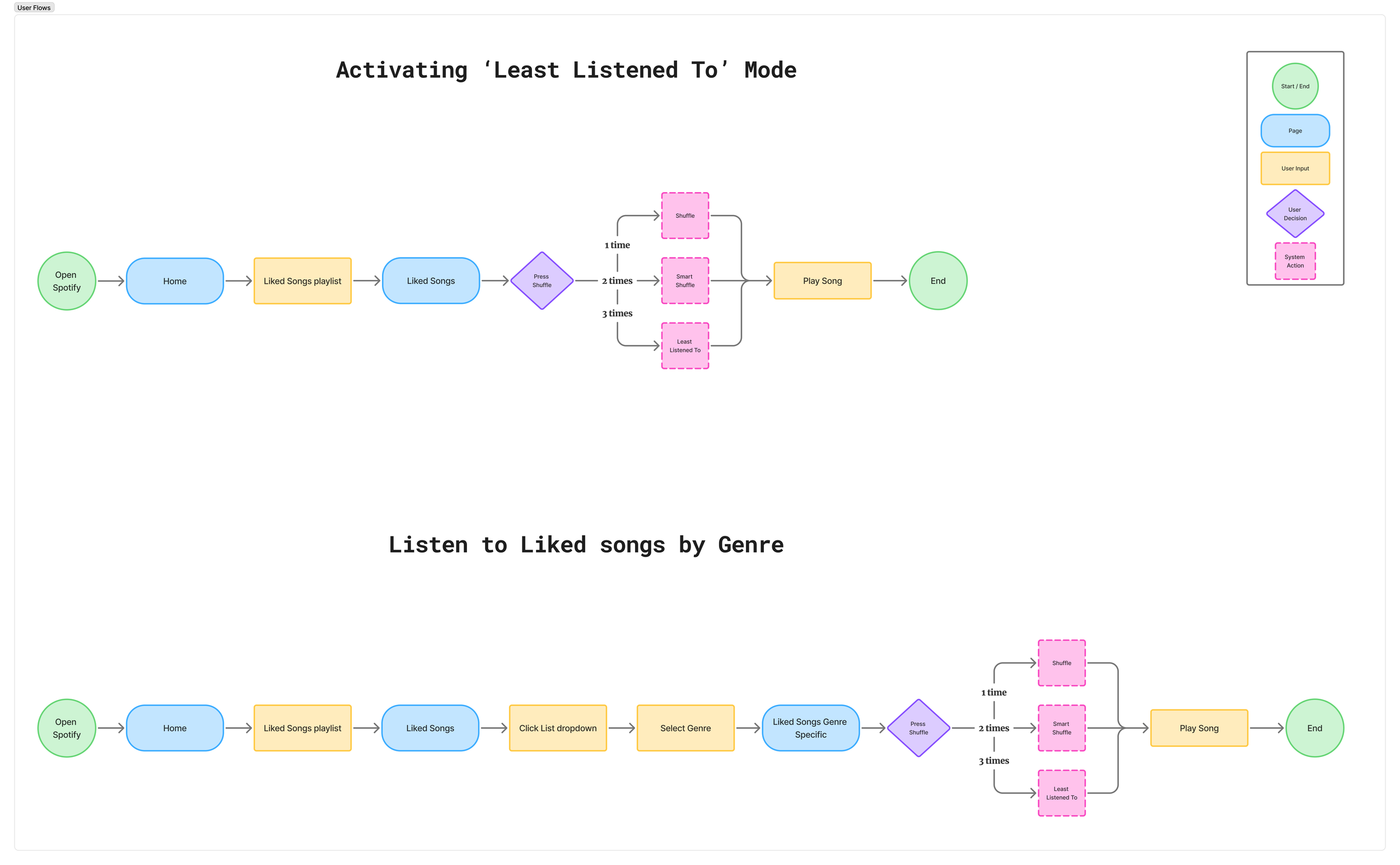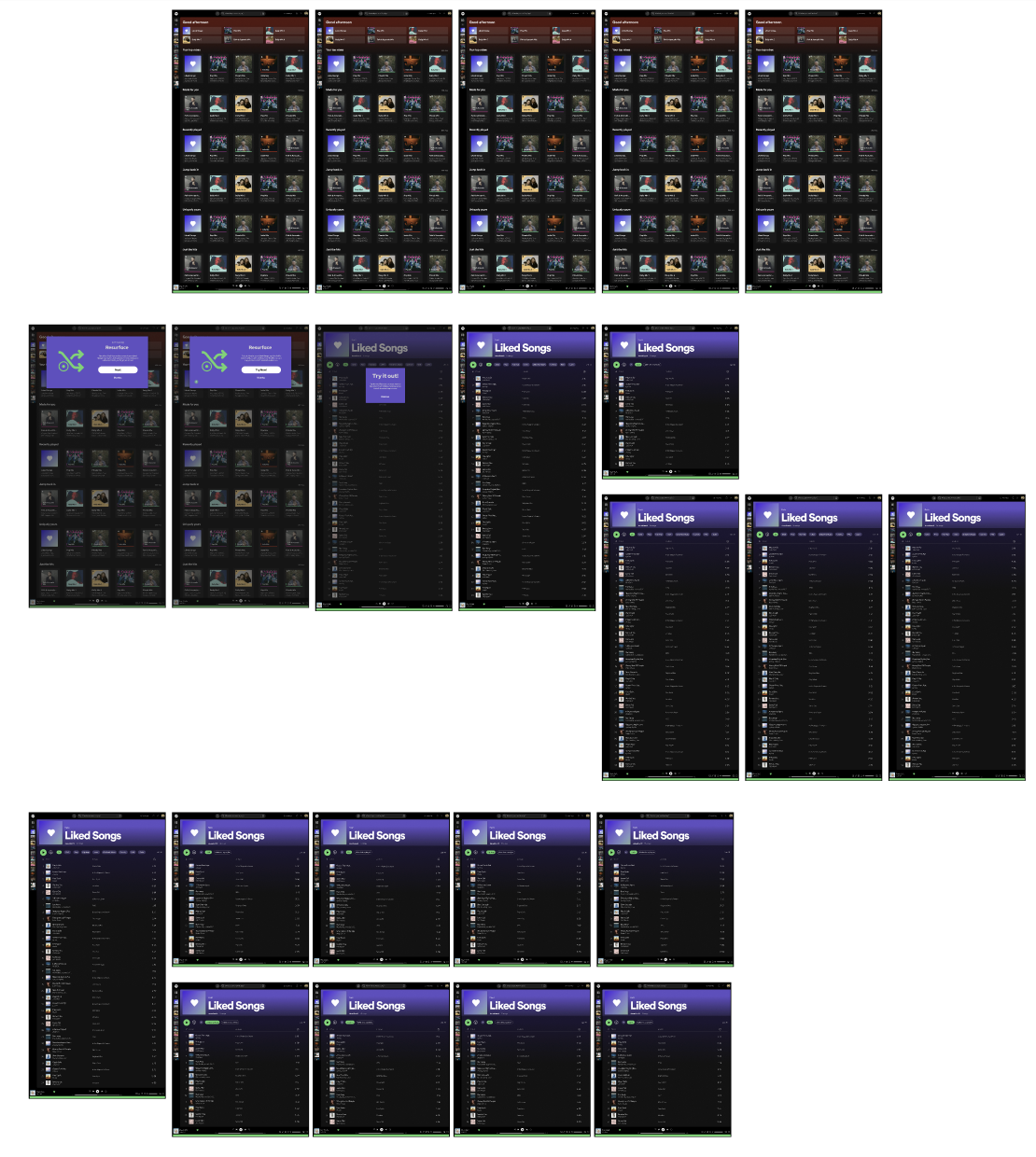Spotify
Spotify Desktop Playback Feature Design
Spotify is one of the most popular music platforms in the world, but even the best products have room for improvement. For this capstone, I designed two desktop playback features to help users get more out of their Liked Songs playlist. This solo project was completed over six weeks and focused on solving a common frustration users experience: hearing the same songs on repeat while others are forgotten.
My Role: End-to-end UX/UI Designer
Tools Used: Figma
Timeline: 6 weeks
Deliverables: Research synthesis, user personas, wireframes, prototypes, usability test results, and design iterations
Problem
Users were frustrated by the repetitive nature of Spotify's Liked Songs playback, often hearing the same recently played tracks while older, less-played favorites were buried.
Goal
Design features that make Spotify’s Liked Songs playlist feel more dynamic and personal by helping users rediscover their full music library and play songs by mood or genre—without having to create new playlists.
Solution
I designed and tested two new features—Resurface Shuffle and Genre Filter—that received positive feedback for their usability and usefulness. Users found the experience more refreshing and aligned with how they actually want to listen to their saved music.
What People Were Saying
-
“I use the Liked Songs playlist a lot, but it feels like I hear the same songs over and over again.”
— Ashley
-
“I wish I could just shuffle by mood or genre without having to make a whole new playlist.”
— Anthony
-
“I like variety, but I don’t have time to organize all my music. I just want it to do that for me.”
— Judy
Research
To guide my design decisions, I collected user insights that shaped my design strategy.
I conducted interviews with five Spotify users who regularly use the Liked Songs playlist. I wanted to understand how they use the shuffle function, whether they feel their music gets stale, and how they rediscover older songs in their library.
Key Insights:
Repetition fatigue: Every participant mentioned that certain songs come up over and over again.
Forgotten favorites: Users often forgot they had liked certain tracks and felt nostalgic when they randomly reappeared.
Desire for better control: There was interest in smarter ways to shuffle or filter songs without having to create new playlists.
Lack of genre balance: Even with a diverse Liked Songs list, Spotify often surfaced music from only a few genres.
These findings guided the rest of the design process
User Personas
James Lee – The Overwhelmed Collector
Feature Connection: Helped inspire the Resurface Shuffle feature to prioritize forgotten songs.
Maya Torres – The Nostalgic Explorer
Feature Connection: Influenced the Genre Filter Carousel, which adds easy mood-based listening options.
These personas helped ensure my features were grounded in real user needs. James reminded me to keep the experience low-maintenance and intuitive, while Maya emphasized the importance of giving users more control over their listening experience without adding complexity.
Affinity Mapping
Repetition Fatigue
Users felt Spotify’s shuffle often favored the same small group of songs.
This led to boredom, disengagement, and reduced interest in using the Liked Songs playlist over time.
Forgotten Favorites
Many users had songs in their Liked Songs that they had completely forgotten about—and felt pleasantly surprised when they reappeared.
There was a clear desire to rediscover music they already enjoyed without having to dig for it.
Desire for More Control
Users wanted smarter shuffle options or filters that felt native to Spotify but gave them more say in what was played.
They didn’t want to build new playlists to solve these problems—just better tools within the existing system.
Genre Diversity Matters
Users had a wide variety of genres in their libraries, but said Spotify seemed to favor just a few.
There was strong interest in a way to surface songs by mood, genre, or vibe—especially without interrupting the Liked Songs flow.
Low-Effort Solutions Win
Both casual and frequent users preferred features that require minimal setup or ongoing maintenance.
Ideal solutions felt automatic, optional, and familiar—like a smarter shuffle button or simple genre tabs
User Flows
Design
I focused on creating features that feel native to Spotify, using their existing design language. Since Spotify already has a well-established visual identity, this project taught me how to adapt my ideas into someone else’s system.
Resurface Shuffle
A smart shuffle mode for Liked Songs. Instead of randomizing the entire list, Resurface Shuffle prioritizes songs that haven’t been played recently. It gives users a fresh way to rediscover the music they once loved.
Genre Filter Carousel
An interactive carousel placed next to the Play button. This lets users instantly filter their Liked Songs by genre (e.g., Chill, Pop, Hip Hop) without creating a new playlist.
I began with low-fidelity wireframes to explore layout options, then transitioned to high-fidelity mockups that closely matched Spotify’s UI. I refined spacing, typography, button styles, pop-up layers, and added micro-interactions consistent with the Spotify brand.
Wireframes
Test
I conducted moderated usability testing with five Spotify users. Sessions were 15–20 minutes and used a clickable high-fidelity prototype in Figma.
Tasks Included:
Navigate to Liked Songs
Activate Resurface Shuffle
Explain what it does
Use Genre Filter
Return to full playlist view
What I Learned:
Resurface Shuffle was sometimes misunderstood as a typical shuffle mode. Users needed clearer visual cues when switching shuffle modes.
Genre Filter was a hit. It was quick to use, felt intuitive, and matched user listening habits.
UI feedback needed enhancement. The shuffle icons were unclear, and some overlays blended too much with the background.
Preliminary visuals outlining site layout and structure.
Iterations Based on Feedback
Following usability testing, I made several updates:
Changed the color of the "All" genre tab from white to green when selected
Fixed layout bugs like “List” and “See All” overlapping
Enhanced pop-ups with drop shadows and rounded corners (4px)
Adjusted pop-up layout to better match Spotify's native UI
Added a shuffle mode banner or label to show which shuffle setting is currently active
Improved the legibility of shuffle icons, especially in smaller sizes
Started exploring genre customization, including additional categories like Rap
Conclusion
This project helped me grow both as a UX thinker and a UI designer. It showed me how to work within an existing brand system, validate ideas with research, and iterate based on real feedback. My biggest takeaway? Even the most beloved products can benefit from thoughtful, user-driven features.
Next Steps
Add an onboarding overlay to introduce Resurface Shuffle when first used
Explore genre tab customization (e.g., reordering or renaming genres)
Consider visually surfacing “least played” songs within the playlist view
Continue refining shuffle icons and interaction clarity
Spotify’s Liked Songs playlist now has more depth, personality, and rediscovery potential—helping users reconnect with the music they already love.
After testing with five Spotify users, 4 out of 5 participants (80%) expressed they would use Resurface Shuffle regularly, and 100% found the Genre Filter intuitive and aligned with their listening habits—resulting in faster task completion and greater playlist satisfaction.
Ready to see it all come together?
Explore the final version of Spotify with added features and see how thoughtful design meets real-world needs.








